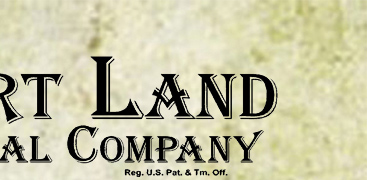610 and 630 Court Street Progress - 2014
December, 2014
Monthly Summary: Working time during December was cut short because the crew had to be diverted to take care of winter storm damage at other Southport Land properties and due to the holidays. At 610 Court Street, more parts of the elevator were installed, the break room floor was installed, the emergency stairway was built, another restroom was completed, and final electrical upgrades to several rooms were completed. The status of 630 Court Street remains unchanged.
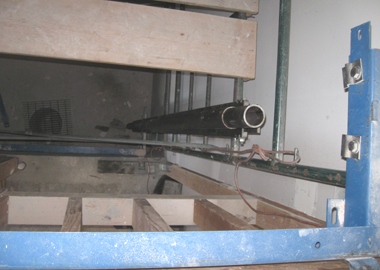 |
610 Court Street: More pieces of the elevator were installed. In this photo, segments of the side rails (the dark circular object in this photo) are being stacked up towards the bracket on the second story (the blue part in this photo). Three of these brackets were installed, one in the pit, one at the floor of the second story, and one above the second story. Because they had to be precisely aligned and properly secured, the installation of the second and third brackets took many days to complete. |
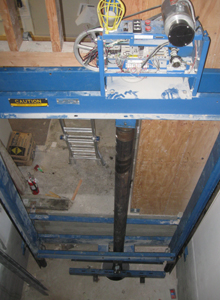 |
610 Court Street: In this photo, the elevator cylinder and piston have been installed, and the frame that will hold the car has been assembled. At the top of the frame sits the motor that will operate the doors. |
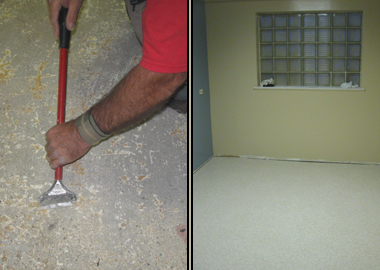 |
610 Court Street: The floor in the break room is removed and a new floor laid down. The photo on the left shows the glue from the old floor being removed with a scraper. The photo on the right shows the new floor after installation. |
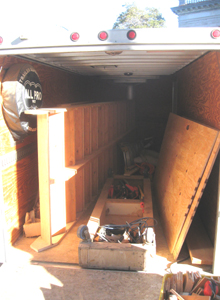 |
610 Court Street: The emergency stairway arrives in pre-built segments, which will be assembled on-site. |
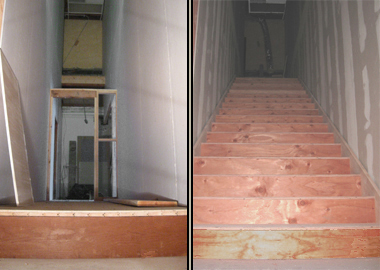 |
610 Court Street: Before and after photos of the emergency stairway. The photo on the left shows the stairwell without any stairs. The photo on the right was taken after the installation. |
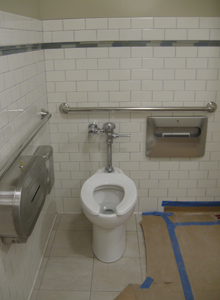 |
610 Court Street: Accessories were added to complete the women's restroom upstairs (the toilet and sink had been previously installed). Brown paper and blue tape protect part of the tile floor. |
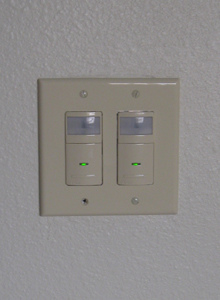 |
610 Court Street: As a part of final electrical upgrades in some rooms, occupancy sensors were installed to comply with California's Title 24 energy conservation requirements. |
November, 2014
Monthly Summary: At 610 Court Street, the tile work in the upstairs restrooms was completed and installation of the fixtures began, the elevator bulkhead received more flashing, the elevator piston and cylinder arrived, assembly of the elevator began, new grids for “T-Bar” ceilings were installed and special ADA-compliant cabinets for the break room arrived. At 630 Court Street measurements were taken to assist the civil engineer in designing theseismic retrofit plans.
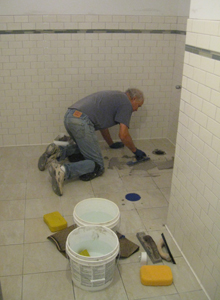 |
610 Court Street: The tiles in the upstairs restrooms received grout. |
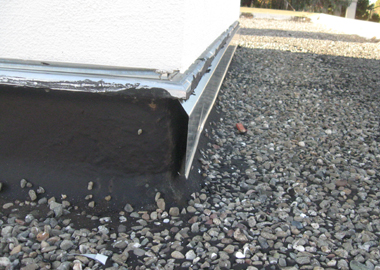 |
610 Court Street: The final layer of flashing around the base of the elevator bulkhead was installed. |
 |
610 Court Street: Workers carry the cylinder (the outer casing for the elevator piston) into the building. The cylinder had to be made longer because the elevator had been built for a smaller traveling distance between the first and second floors. |
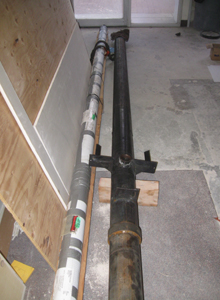 |
610 Court Street: The elevator piston arrived from the manufacturer, Bore-Max Corporation, located in El Monte, California. In this photo, the piston is in a shipping tube on the left, next to its cylinder, on the right. |
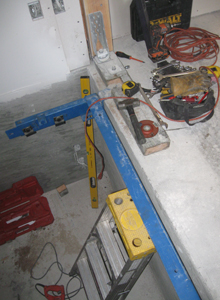 |
610 Court Street: The first pieces of the elevator are installed. In this photo, a blue bracket to hold the side rails of the elevator has been installed in the pit. |
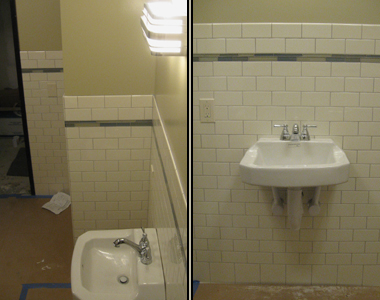 |
610 Court Street: Fixtures in both of the upstairs restrooms, appropriate for the building’s Streamline Moderne architecture, were installed. These include lights with chrome bands and a sink with a geometrical shape that complies with the Americans with Disabilities Act. (Brown paper protects the floor tile.) |
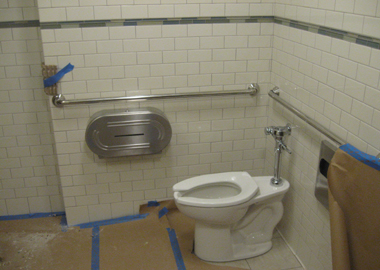 |
610 Court Street: Stainless steel and chrome accessories were installed in the upstairs men's restroom, in the locations required by the Americans with Disabilities Act. (In this photo, brown paper with blue seams protects the floor tile.) |
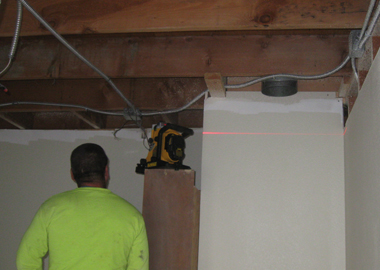 |
610 Court Street: An exposed “T-bar” grid system, to eventually hold acoustical ceiling tiles, was added in rooms where the old grid system had been compromised by new construction. In this photo, a rotating laser is being used to project the outside edges of the new grid system on the walls, in preparation for installing the first bars. |
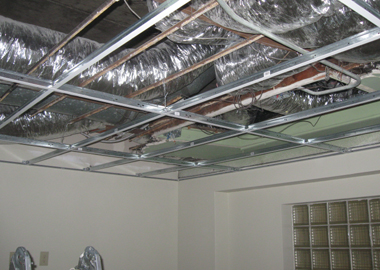 |
610 Court Street: New drop “T-bar” grid system after installation (the acoustical tiles have yet to be laid between the bars). |
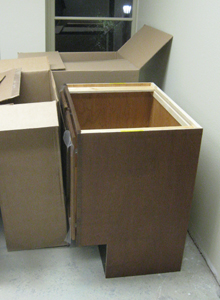 |
610 Court Street: Cabinets for the Break Room arrived from the manufacturer. These cabinets have a larger toe kick area and shorter depth in order to comply with the Americans with Disabilities Act. |
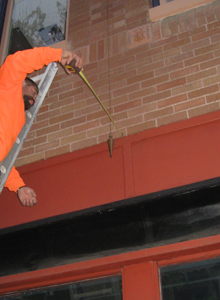 |
630 Court Street: Measurements are taken to assist in the design of the seismic retrofit work. In this photo, a string line and plumb bob have been run down from the building’s cornice so that measurements could be taken from the string line over to the brick wall, in order to determine if the wall is plumb. |
October, 2014
Monthly Summary: At 610 Court Street, work commenced on tiling the upstairs restrooms, modifications to comply with the Americans with Disabilities Act continued to be made, many of the upstairs walls received spray‑on texture followed by painting, all upstairs windows were re-installed, and pre-existing defects continued to be repaired. The status of 630 Court Street remains unchanged.
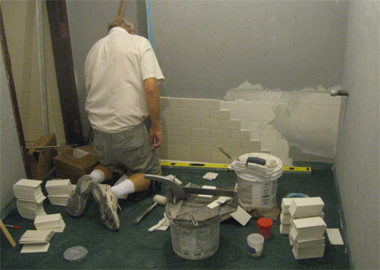 |
610 Court Street: Work commenced on installing tiles in the upstairs restrooms. |
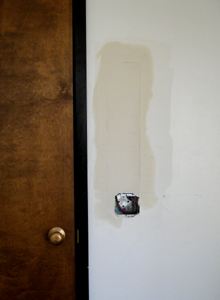 |
610 Court Street: Existing light switches were lowered to comply with the Americans with Disabilities Act. In this photo, fresh sheetrock mud covers the patch that was required to do the work. |
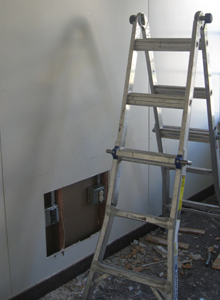 |
610 Court Street: Existing electrical receptacles and telephone jacks were raised to comply with the Americans with Disabilities Act. This photo shows a hole cut in the sheetrock to perform the work. |
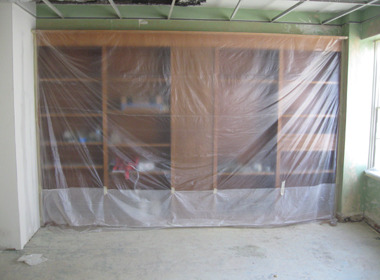 |
610 Court Street: Thin plastic is placed over built-in bookcases and windows in preparation for spraying texture on the walls of the upstairs offices. |
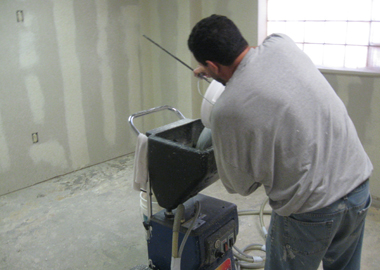 |
610 Court Street: A worker fills the hopper of the texture spraying machine. |
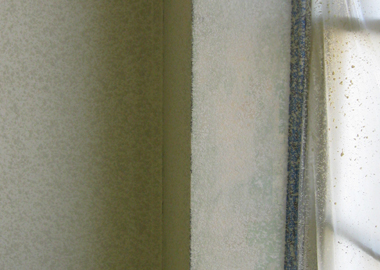 |
610 Court Street: Texture after being sprayed on the walls of an upstairs office. |
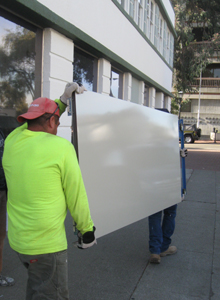 |
610 Court Street: Elevator doors are delivered after being painted off site. |
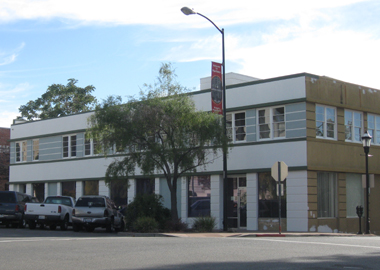 |
610 Court Street: The task of re-installing all of the wooden windows on the upper floor was completed. The windows had recently been refurbished by an off site vendor, then repainted on site. |
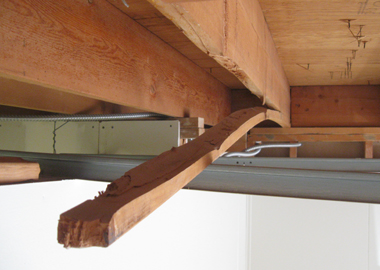 |
610 Court Street: Pre-existing defects continue to be discovered. When the ceiling tiles were removed in an office, a split roof rafter, directly under an HVAC unit, was discovered. It has subsequently been replaced. |
September, 2014
Monthly Summary: Significant steps forward were taken in September despite the fact that a few days’ worth of time was lost when some of the crew were diverted to work on stabilizing a historic building damaged in the South Napa Earthquake of August 24, 2014. At 610 Court Street roofing material was added to the elevator bulkhead, the area around the bulkhead was re‑roofed, progress was made on the exterior façades (including windows), and the elevator doors were delivered to a vendor for painting. The status of 630 Court Street remains unchanged.
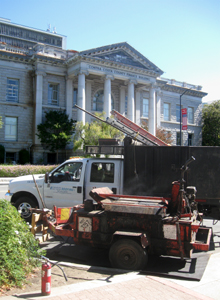 |
610 Court Street: A hot tar kettle is set‑up for roofing the elevator bulkhead and re‑roofing the area that had to be disturbed around it. |
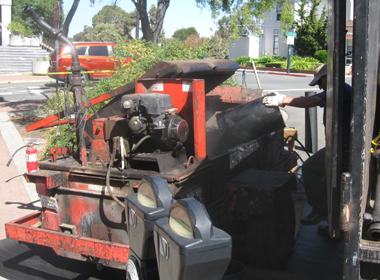 |
610 Court Street: A cylinder‑shaped piece of asphalt, weighing 100 pounds, is gently placed into the hot tar kettle to be melted. |
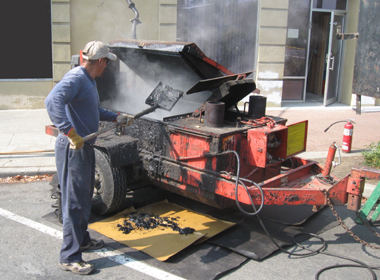 |
610 Court Street: After the asphalt is heated, scum that floats to the top is removed with a screen shaped like a shovel. |
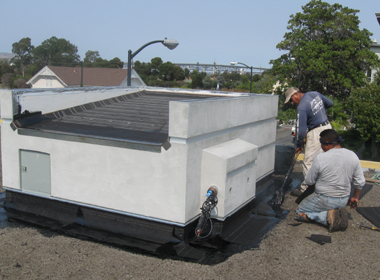 |
610 Court Street: A roofing crew works to apply hot asphalt to the area around the elevator bulkhead. |
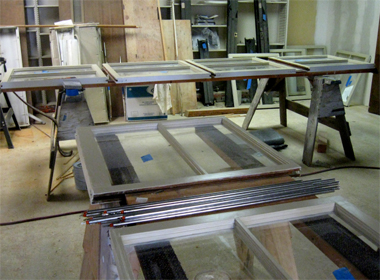 |
610 Court Street: Windows receive paint on the interior‑facing side before re‑installation. The silver‑colored tubes in the foreground of the photo are “spiral sash balances” which match the originals, which had become worn‑out. These tubes contain a spiral-shaped steel rod that is connected to a spring. When first installed, the spring is wound‑up, which stores energy. When the window is raised, the stored energy is released, creating a lifting force, and providing counterbalance for the weight of the window. |
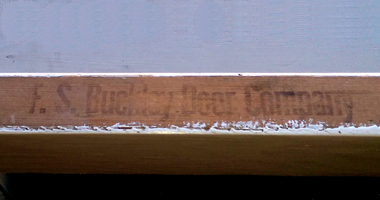 |
610 Court Street: During the painting process, several old window frames were found to contain the stamp of the manufacturer, F. S. Buckley Door Company. |
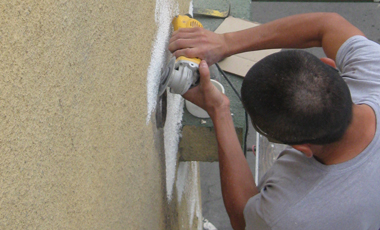 |
610 Court Street: A worker cleans the area around a roof drain prior to repairing it. |
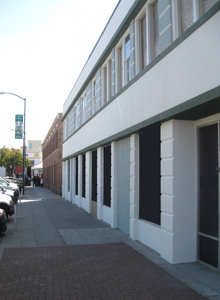 |
610 Court Street: The painting of the Court Street façade was completed. (In this photo, many of the upper story windows have yet to be re‑installed.) The paint scheme emphasizes the horizontal lines of the building’s Streamline Moderne architecture. |
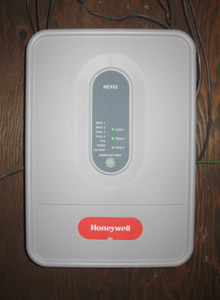 |
610 Court Street: A zone control panel for one of the four HVAC systems in the building was installed. |
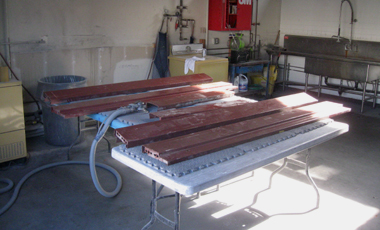 |
610 Court Street: The elevator doors and frames arrived at the vendor for painting. |
August, 2014
Monthly Summary: High productivity continued during August , 2014. At 630 Court Street testing on the bricks and concrete foundation was completed and the report submitted to both the City of Martinez and the engineer who is designing the seismic retrofit work. At 610 Court Street the elevator equipment room was almost completed, the elevator shaft bulkhead was stuccoed, all of the building’s windows were removed and sent out for rehabilitation work, preparations for patching took place on the roof, and additional segments of the exterior were painted.
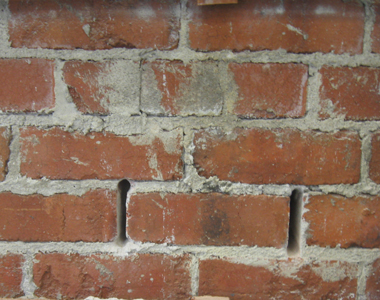 |
630 Court Street: In-place mortar shear testing begins by removing the mortar joints at each end of a brick. |
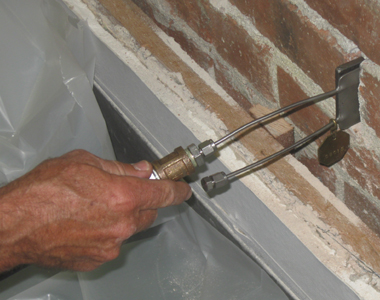 |
630 Court Street:A hydraulic flat jack is inserted at one end of the brick to be tested. |
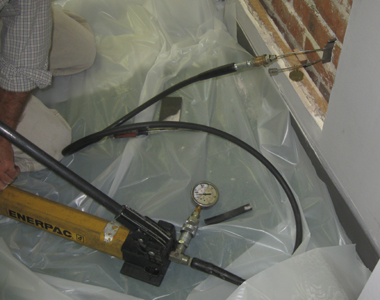 |
630 Court Street: Loads were applied to the test brick by a hydraulic system consisting of a portable hydraulic hand pump, pressure gauge and hydraulic flat jack. When the test brick showed initial signs of movement, the load was recorded. |
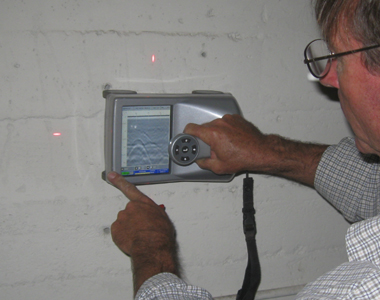 |
630 Court Street: Using a Ground Penetrating Radar Scanner, an “In-Situ Reinforcement Survey” is conducted on the building’s foundation to determine the amount of rebar in the concrete. |
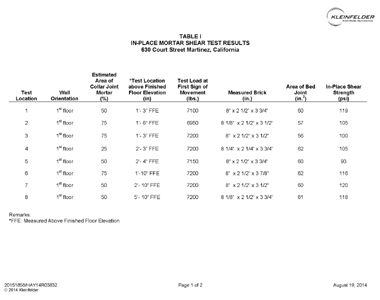 |
630 Court Street: After the brick and concrete tests were completed, a report was prepared and submitted to both the City of Martinez and the engineer who is designing the seismic retrofit work. |
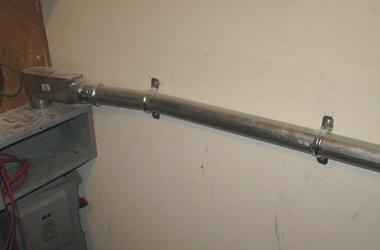 |
610 Court Street: An electrical conduit is run to the elevator equipment room. |
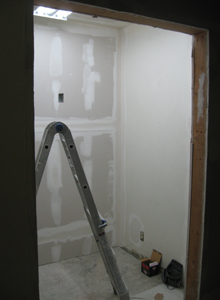 |
610 Court Street: The elevator equipment room takes shape in this photo. |
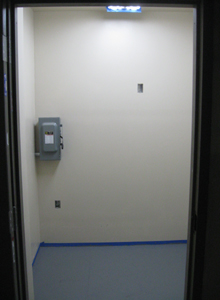 |
610 Court Street: The nearly complete elevator equipment room. |
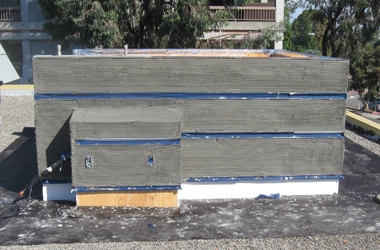 |
610 Court Street: The elevator shaft bulkhead was stuccoed. In this photo, the stucco “scratch coat” has been applied. |
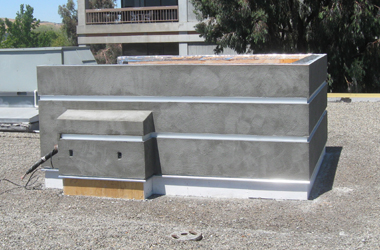 |
610 Court Street: This photo was taken after the stucco “top coat” had been applied to the elevator shaft bulkhead. This photo also shows the effect created by the horizontal aluminum “channel screed,” which was installed to simulate the horizontal grooves in the stucco on the lower floors of the building . |
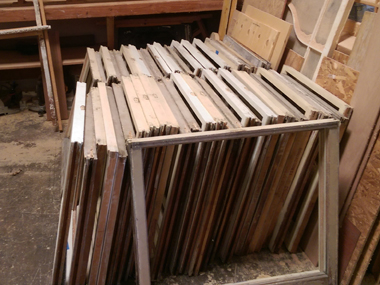 |
610 Court Street: All of the windows in the building were removed and sent out to be rehabilitated. In this photo, the windows sit at The Window Shop in Concord, California, waiting to be worked on. |
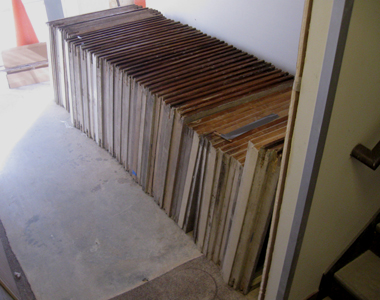 |
610 Court Street: After being worked on, the windows are returned to the building. In this photo, the windows are stacked-up, waiting to be painted. |
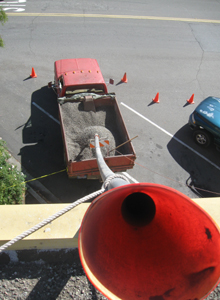 |
610 Court Street: Loose gravel is removed from the roof to facilitate roof patching. In this photo, an old traffic cone acts as a funnel leading to a PVC pipe that sends the gravel down to a waiting dump truck. |
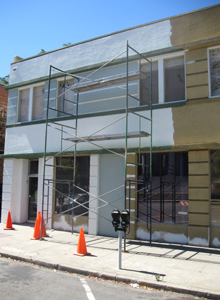 |
610 Court Street: Scaffolding is set-up to paint another section of the building. The exterior is being painted in sections when there is available time. Interior work takes precedence because of the coordination of third-party contractors. |
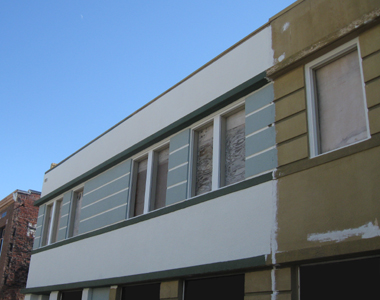 |
610 Court Street: In this photo, painting has been nearly completed on a section of the building. |
July, 2014
Monthly Summary: July, 2014 was another very productive month. At 610 Court Street the elevator shaft pierced the roof line, and was nearly completed. At 630 Court Street, preparations began for testing the bricks prior to finishing the design of seismic retrofit work.
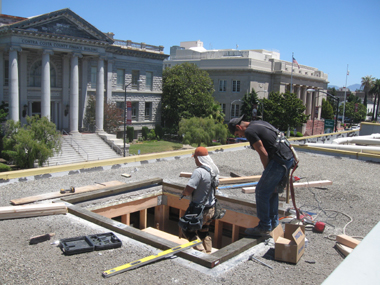 |
610 Court Street: Sill plates are laid on the concrete roof to begin construction of the portion of the elevator shaft that will be above the roof line, also called an “elevator shaft bulkhead.” |
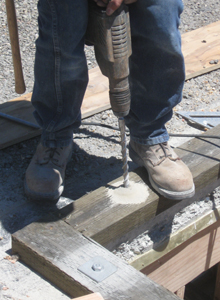 |
610 Court Street: Holes are drilled through the sill plates and through the concrete roof so that lag bolts can be installed into the wooden beams below. |
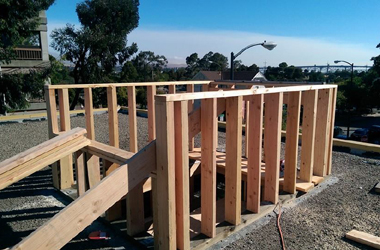 |
610 Court Street: The elevator shaft bulkhead takes shape as framing is nearly completed. |
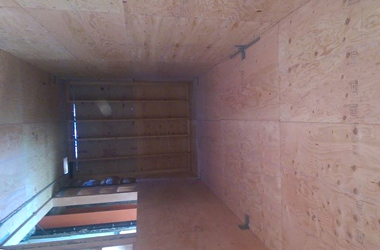 |
610 Court Street: Plywood shear is added to the inside of the elevator shaft. |
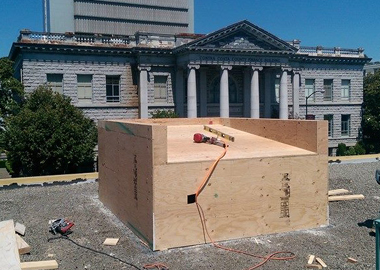 |
610 Court Street: Plywood is added to the outside of the elevator shaft bulkhead. |
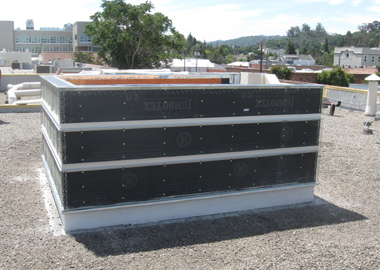 |
610 Court Street: Waterproofing material and metal lath are added to the plywood so that it can be stuccoed. Also, aluminum “channel screed” has been placed on the shaft’s exterior to closely match the horizontal bands in the stucco on the first and second stories of the building. |
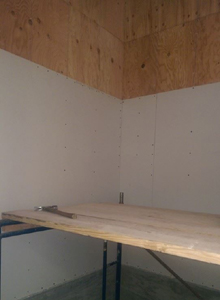 |
610 Court Street: Sheetrock is added over the shear plywood on the interior of the elevator shaft. A second layer of sheetrock will be added before the interior is finished. |
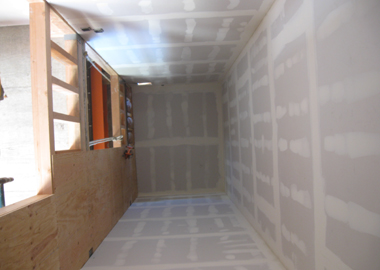 |
610 Court Street: In this photo, two layers of sheetrock have been placed over the plywood on three sides of the interior of the elevator shaft. The front side of the shaft will not receive sheetrock until after the elevator has been partially installed. |
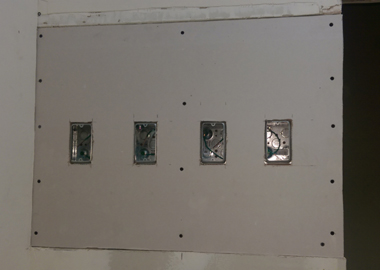 |
610 Court Street: In the elevator equipment room, electrical boxes are added for elevator control and alarm modules. |
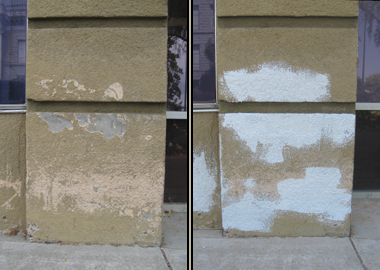 |
610 Court Street: Over the years, portions of the stucco top coat have come off of the building’s exterior (the grey patches in the photo on the left). The photo on the right shows the same area after a special stipple paint has been applied, which is intended to restore the texture as nearly as possible. |
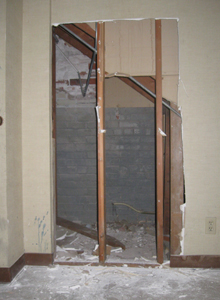 |
630 Court Street: In preparation for “in-place mortar shear strength tests” holes were cut into interior walls to expose the inside layer of bricks in the perimeter walls. In this photo, a section of wall has been removed under a stairway to reveal one of the testing areas. These tests should not affect the outer layer of bricks that form the building’s façade. The results of the tests will be used to finish the design of the work that must be undertaken to reinforce the building against earthquakes. |
June, 2014
Monthly Summary: June, 2014 was perhaps the most productive month thus far at 610 Court Street. The framing for the elevator shaft reached the concrete roof, while work was done on the exterior. The status of 630 Court Street remains unchanged.
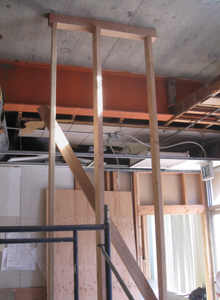 |
610 Court Street: Temporary supports are installed before the concrete slab between the first and second stories is removed in the area of the elevator shaft. |
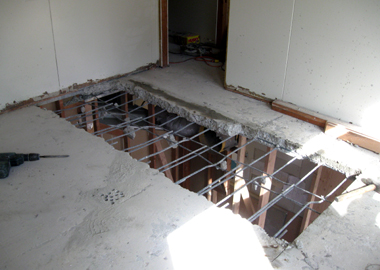 |
610 Court Street: Work on removing the concrete slab between the first and second stories is about half‑way complete in this photo. |
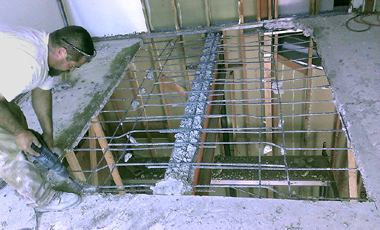 |
610 Court Street: The removal of the concrete slab between the first and second stories is nearly complete. The narrow area in the middle is where the I‑beam lies below, which must be removed for the elevator shaft. |
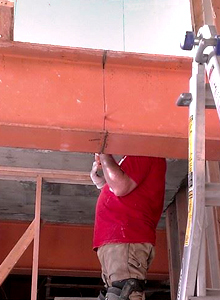 |
610 Court Street: After removal of the concrete slab between the first and second stories, the 20‑inch high I‑beam is cut into segments for removal. |
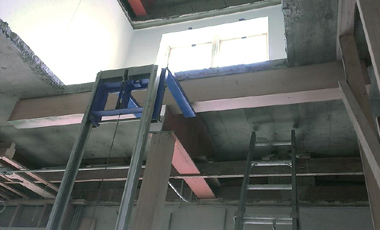 |
610 Court Street: With the concrete and I-beam out of the way, 6x10 beams are raised into position around the perimeter of the elevator shaft to support the remaining concrete of the slab between the first and second stories. |
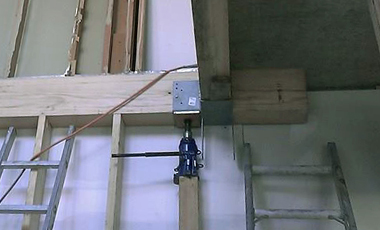 |
610 Court Street: Four 6x10 beams, one on each side of the elevator shaft, are connected together with steel saddles and jacked up tight against the concrete slab between the first and second stories. This process was later repeated on the second story, with the beams being jacked up against the concrete roof. |
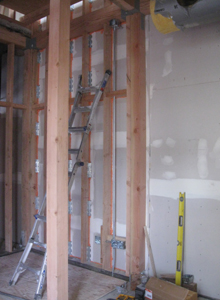 |
610 Court Street: Posts and studs are added below the 6x10 beams in the elevator shaft. Electrical conduit is added for lights and an emergency stop switch. Because this wall is being built against an existing wall, orange‑colored fire sealing foam has been added between the existing wall and the vertical members of the shaft. |
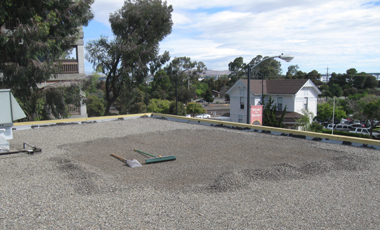 |
610 Court Street: Once the framing was completed below the concrete roof, it was time to prepare the roof for removal of the slab. In this photo, the gravel coating of the roof is being cleared above where the elevator shaft lies below. |
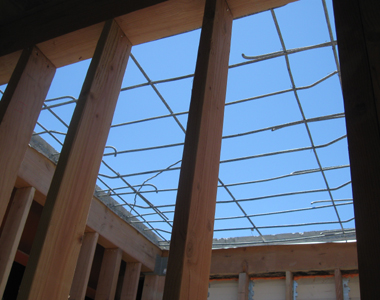 |
610 Court Street: Sky is seen through the rebar where the concrete roof has been removed for the elevator shaft. The shaft must continue past the roof by about thirty inches to provide a refuge space for when the elevator is being serviced. |
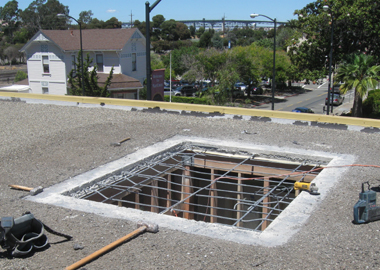 |
610 Court Street: The removed roof slab, as seen from above. |
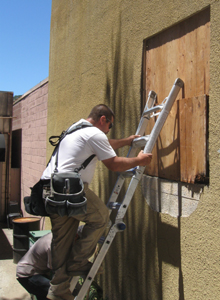 |
610 Court Street: Plywood is removed from windows in the private alley on the south side of the building. A prior owner of the building had covered the windows. |
May, 2014
Monthly Summary: At 610 Court Street work on the elevator continued. The status of 630 Court Street remains unchanged.
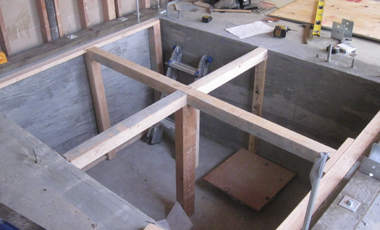 |
610 Court Street: Supports for a temporary floor are added to the elevator pit. Plywood will be placed over these supports to protect the pit during the removal of the concrete ceiling above. |
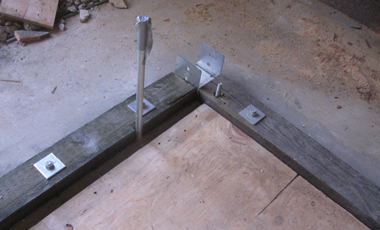 |
610 Court Street: Metal column bases and wooden 3x6 sill plates are added around the elevator pit to start construction of the shaft walls. |
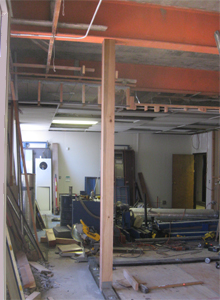 |
610 Court Street: After waiting nearly a month for the concrete in the pit walls to achieve full design strength, a 6x6 column is added under the steel I-Beam that traverses the area where the elevator shaft will be constructed. This I-Beam will be cut and the portion that is in the way of the shaft will be removed. |
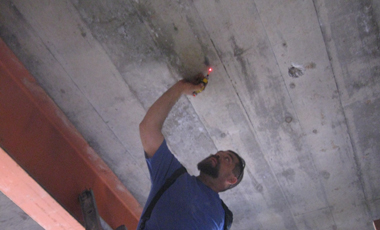 |
610 Court Street: Using a laser, the inside edges of the sill plates are projected onto the concrete ceiling and marked with a dot. The dots will be connected and then scored with a diamond saw before removal of the concrete begins. |
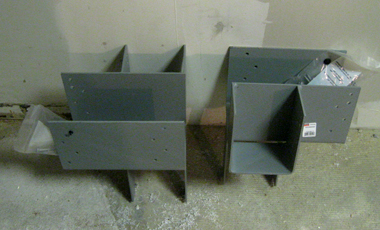 |
610 Court Street: High capacity steel connector caps (also called “saddles”), to be used at the top of eight of the elevator shaft’s eleven 6x6 columns, arrived from the distributor. These caps will tie the columns to 6x10 horizontal beams under the concrete floor of the second story and the roof. |
April, 2014
Monthly Summary: At 610 Court Street the walls of the elevator pit were formed-up, anchor bolts were positioned, and concrete was poured. The status of 630 Court Street remains unchanged.
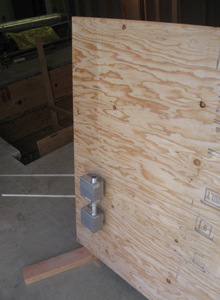 |
610 Court Street: A section of concrete form board is prepared outside the pit. This form board is for a section of wall that will have electrical boxes and conduit embedded into the concrete, so the boxes are fastened to the form board. |
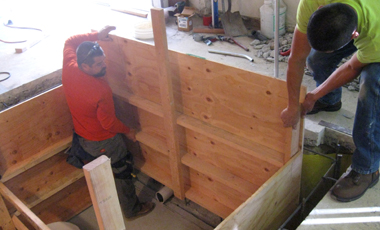 |
610 Court Street: A section of concrete form board is lowered into position in the elevator pit. |
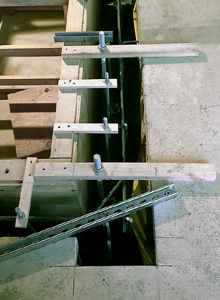 |
610 Court Street: Anchor bolts are positioned per the engineering plans. Here, metal strut holds anchors that only protrude a short distance above the finished concrete, while wood slats hold anchors that will protrude above the sill plate of the elevator shaft wall. |
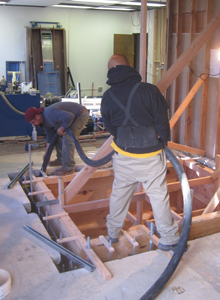 |
610 Court Street: After being secured to prevent movement, concrete is pumped into the form. |
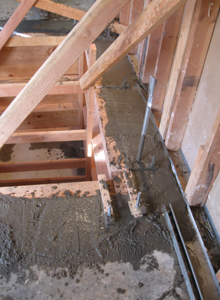 |
610 Court Street: Concrete in a portion of the pit wall before being finished. |
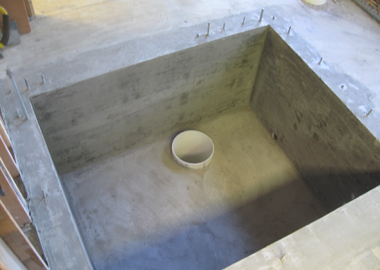 |
610 Court Street: After the form boards have been removed, a perfect pit wall is revealed. The concrete will be allowed to cure before being loaded with any weight. The large hole in the pit floor is for the elevator’s piston, and the small hole farther to the right, at the bottom of the pit wall, is a pipe leading to the sump pump. |
March, 2014
Monthly Summary: At 610 Court Street concrete was poured to form the floor of the elevator pit, and the pit’s sump pump housing was installed. The status of 630 Court Street remains unchanged.
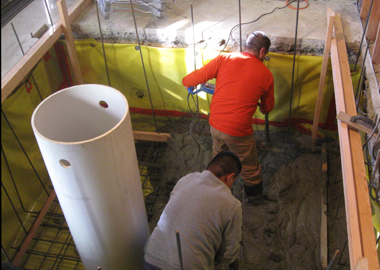 |
610 Court Street: Concrete is poured to form the pit floor. A worker directs a concrete pump’s hose while another worker operates a concrete vibrator. |
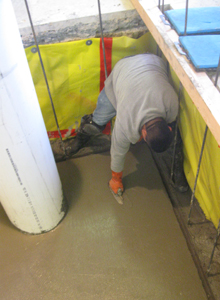 |
610 Court Street: Finishing touches are added to the newly poured concrete of the elevator pit floor. |
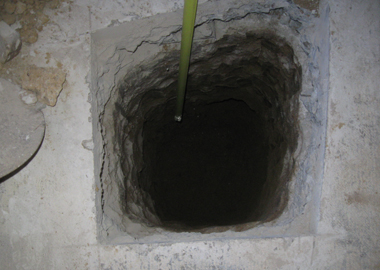 |
610 Court Street: A hole for the sump pump housing is dug a few feet away from the elevator pit. The sump pump will remove any water that might enter the elevator pit. |
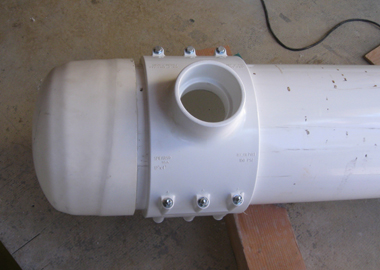 |
610 Court Street: The sump pump’s housing, made of 12-inch diameter PVC pipe and fittings, is assembled. A 4-inch diameter pipe will be inserted into the hole on the side of the housing, to connect with the floor of the elevator pit. |
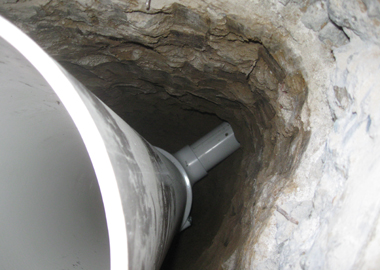 |
610 Court Street: The elevator pit’s sump pump housing, after installation. The pipe at the bottom of the hole connects with the elevator pit. Any water that should enter into the pit will flow through the smaller diameter pipe and into the sump pump housing, where it will be removed by the sump pump. |
February, 2014
Monthly Summary: At 610 Court Street the floor of the elevator pit was prepared for concrete. On the exterior, stucco was patched and possible colors tested. The status of 630 Court Street remains unchanged.
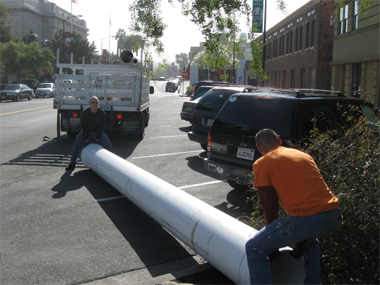 |
610 Court Street: The 18-inch diameter plastic pipe to line the piston hole, which had been shipped from the Seattle area, is maneuvered after arriving on a truck from the manufacturer’s local distributor. |
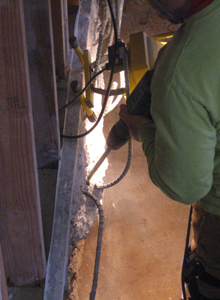 |
610 Court Street: A section of concrete flooring that was too thick for the full depth of a concrete saw blade, is chipped away at the edge of the elevator pit. |
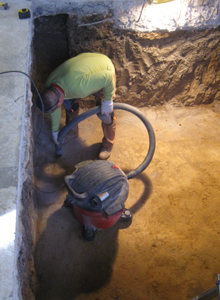 |
610 Court Street: The pit is vacuumed prior to laying down a vapor barrier. Because the vapor barrier is made of thin plastic, if something such as a small stone were to be left on the pit floor, a hole might be put in the vapor barrier if a worker was to step in that spot. |
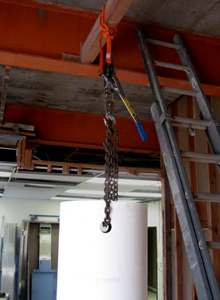 |
610 Court Street: After being cut to a workable length, the pipe for lining the piston hole is suspended by chains above the hole. |
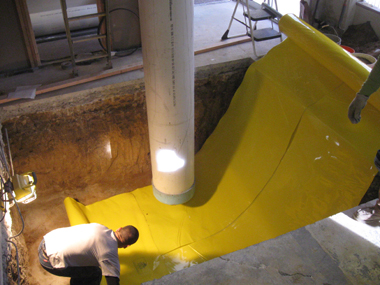 |
610 Court Street: A piece of vapor barrier, large enough to cover all of the pit’s bottom and most of its sides, is pulled off of a larger roll. |
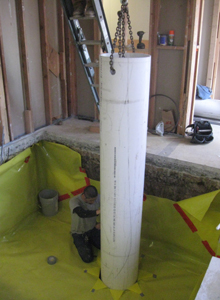 |
610 Court Street: After a star-shaped slit is made in the vapor barrier over the piston hole, the plastic pipe used to line the hole is slowly lowered through the slit and into the hole. |
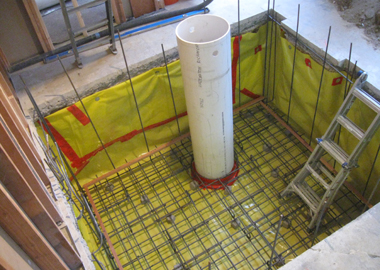 |
610 Court Street: After the piston liner is plumbed and the area between the pipe and the edge of the hole is packed with pea gravel, two layers of rebar are placed on the pit floor as reinforcement for the concrete. The red tape seals joints in, and penetrations through, the vapor barrier. |
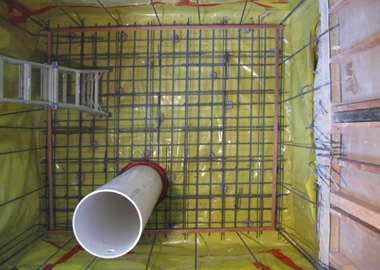 |
610 Court Street: The elevator pit floor, ready for concrete, as seen from above. |
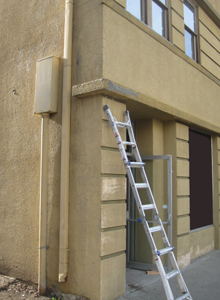 |
610 Court Street: On the exterior, a missing piece of stucco is patched. |
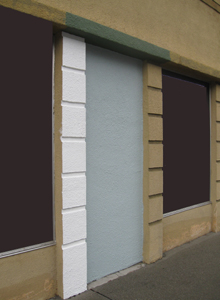 |
610 Court Street: Possible colors are tested on the front of the building. All of the colors being considered can be seen on our 610 Building Exterior Colors webpage, which we will update as more colors are explored. |
January, 2014
Monthly Summary: At 610 Court Street the proper depth of the elevator pit was reached, walls were prepared for sheetrock, and more sheetrock was put in place. The status of 630 Court Street remains unchanged.
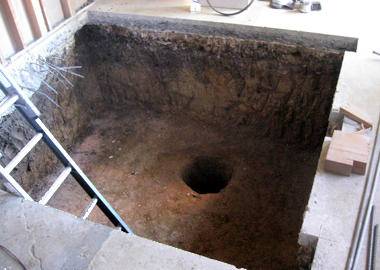 |
610 Court Street: The digging of the elevator pit and the piston hole was completed. Before laying in the rebar and pouring concrete, the piston hole has to be lined with a plastic pipe which is not locally stocked. The pipe has to be shipped from a manufacturer in the Seattle area. |
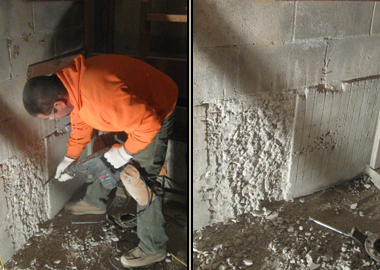 |
610 Court Street: A worker prepares one of the original concrete walls for sheetrock. This particular wall had a bulge that probably resulted from a shift in the concrete forms when the wall was originally poured over 50 years ago. In these photos, the bulge is removed by scoring the area to the proper depth with a diamond blade, then removing the excess concrete with a roto-hammer. |
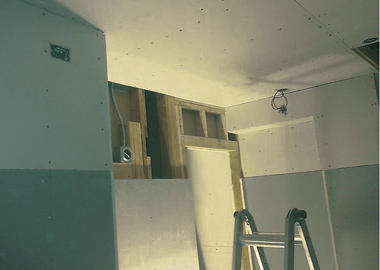 |
610 Court Street: Putting-up more sheetrock. The darker colored sheetrock is a special product used as a backing for tile. |
|
| |
|
| |

